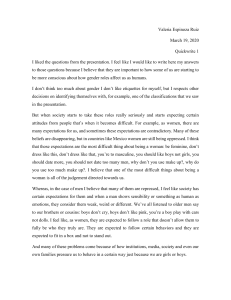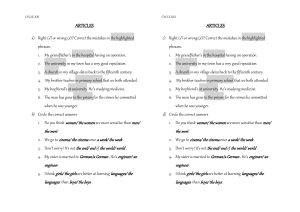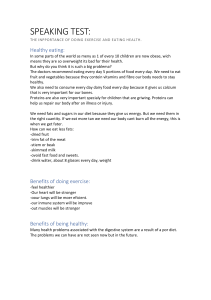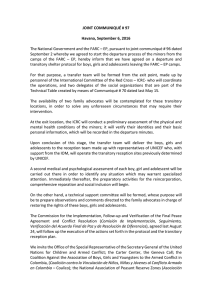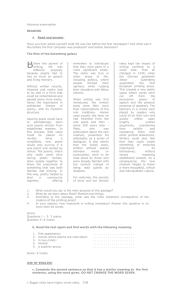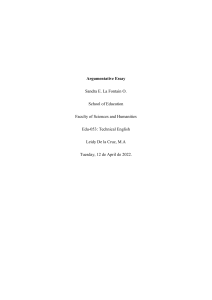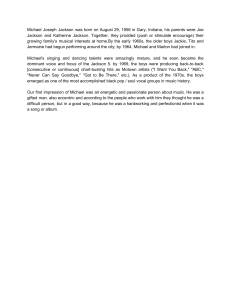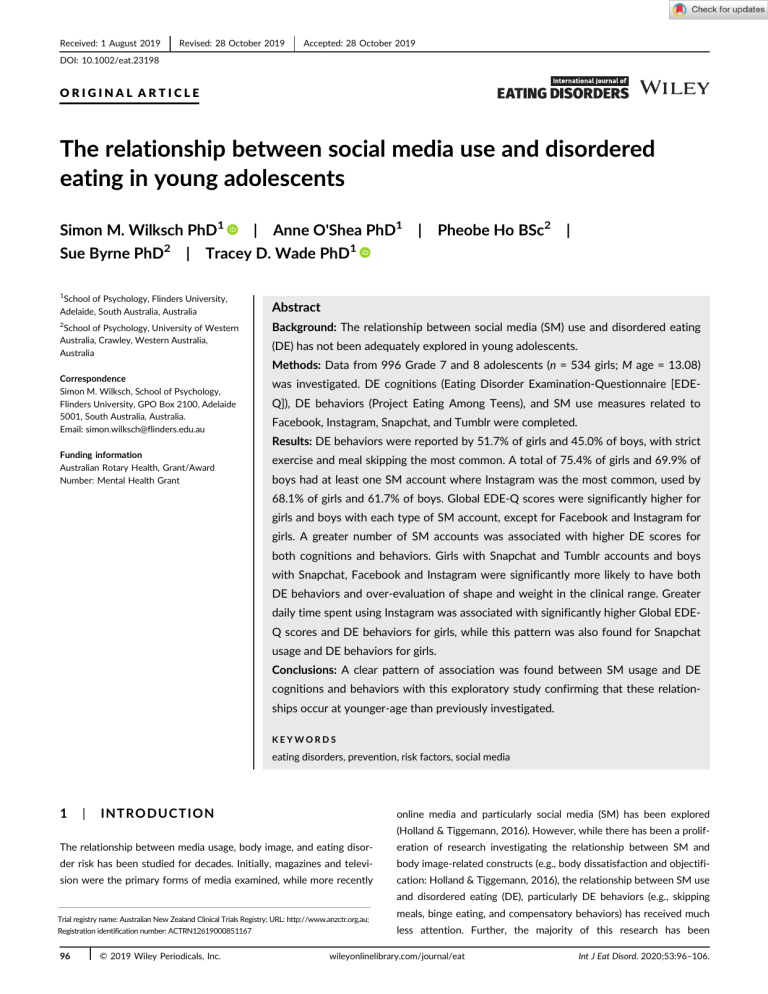
Received: 1 August 2019 Revised: 28 October 2019 Accepted: 28 October 2019 DOI: 10.1002/eat.23198 ORIGINAL ARTICLE The relationship between social media use and disordered eating in young adolescents Simon M. Wilksch PhD1 | Anne O'Shea PhD1 Sue Byrne PhD2 | Tracey D. Wade PhD1 1 School of Psychology, Flinders University, Adelaide, South Australia, Australia 2 School of Psychology, University of Western Australia, Crawley, Western Australia, Australia | Pheobe Ho BSc2 | Abstract Background: The relationship between social media (SM) use and disordered eating (DE) has not been adequately explored in young adolescents. Methods: Data from 996 Grade 7 and 8 adolescents (n = 534 girls; M age = 13.08) Correspondence Simon M. Wilksch, School of Psychology, Flinders University, GPO Box 2100, Adelaide 5001, South Australia, Australia. Email: [email protected] was investigated. DE cognitions (Eating Disorder Examination-Questionnaire [EDEQ]), DE behaviors (Project Eating Among Teens), and SM use measures related to Facebook, Instagram, Snapchat, and Tumblr were completed. Results: DE behaviors were reported by 51.7% of girls and 45.0% of boys, with strict Funding information Australian Rotary Health, Grant/Award Number: Mental Health Grant exercise and meal skipping the most common. A total of 75.4% of girls and 69.9% of boys had at least one SM account where Instagram was the most common, used by 68.1% of girls and 61.7% of boys. Global EDE-Q scores were significantly higher for girls and boys with each type of SM account, except for Facebook and Instagram for girls. A greater number of SM accounts was associated with higher DE scores for both cognitions and behaviors. Girls with Snapchat and Tumblr accounts and boys with Snapchat, Facebook and Instagram were significantly more likely to have both DE behaviors and over-evaluation of shape and weight in the clinical range. Greater daily time spent using Instagram was associated with significantly higher Global EDEQ scores and DE behaviors for girls, while this pattern was also found for Snapchat usage and DE behaviors for girls. Conclusions: A clear pattern of association was found between SM usage and DE cognitions and behaviors with this exploratory study confirming that these relationships occur at younger-age than previously investigated. KEYWORDS eating disorders, prevention, risk factors, social media 1 | I N T RO DU CT I O N online media and particularly social media (SM) has been explored (Holland & Tiggemann, 2016). However, while there has been a prolif- The relationship between media usage, body image, and eating disor- eration of research investigating the relationship between SM and der risk has been studied for decades. Initially, magazines and televi- body image-related constructs (e.g., body dissatisfaction and objectifi- sion were the primary forms of media examined, while more recently cation: Holland & Tiggemann, 2016), the relationship between SM use and disordered eating (DE), particularly DE behaviors (e.g., skipping Trial registry name: Australian New Zealand Clinical Trials Registry; URL: http://www.anzctr.org.au; Registration identification number: ACTRN12619000851167 96 © 2019 Wiley Periodicals, Inc. meals, binge eating, and compensatory behaviors) has received much less attention. Further, the majority of this research has been wileyonlinelibrary.com/journal/eat Int J Eat Disord. 2020;53:96–106. conducted with young-adult women (e.g., Hummel & Smith, 2015; Smith, use in 237 Hispanic female adolescents (M = 14.11 years) from Texas, Hames, & Joiner, 2013). Thus, the relationship between SM and DE in United States and found no relationship with either television exposure young-adolescent girls and boys has not been adequately investigated. to the thin ideal or SM use and Eating Attitudes Test scores. This needs to be addressed given that 13 years is the minimum required To the best of our knowledge, of the few studies to examine the age for accessing many SM accounts (e.g., Facebook, Instagram, relationship between SM use and DE, all apart from one have focused Snaphcat, and Tumblr), and early adolescence is a time of increased DE exclusively on cognitions, while Smith et al. (2013) also included one risk (Gowers & Shore, 2001). Further, given that media literacy is the specific behavior, namely overeating. Maladaptive Facebook usage leading approach to ED risk reduction in young-adolescence (Wilksch (defined as using Facebook for social comparisons) at baseline was et al., 2015), if SM is associated with increased DE risk, content targeting found to be positively associated with episodes of over-eating at SM use could readily be incorporated in such programs. 4-week follow-up (Smith et al., 2013). One of the few studies to use DE consists of both cognitions (measured in the current study the EDE-Q to measure DE explored racial differences in young-adult with the Eating Disorder Examination-Questionnaire global [EDE-Q women (N = 922). Findings indicated that the frequency of Facebook Global]: Fairburn & Beglin, 1994) and behaviors (Haines, Neumark- usage was not related to DE, but users who sought reassurance from Sztainer, Eisenberg, & Hannan, 2006). A recent Australian study found their Facebook followers (e.g., expecting followers to comment on 25.3% of adolescents aged 13 and 35.4% aged 14 were engaging in their posts) had higher DE scores than those who did not (Howard, DE behaviors (N = 202: Sparti, Santomauro, Cruwys, Burgess, & Har- Heron, MacIntyre, Myers, & Everhart, 2017). There has been some ris, 2019) as assessed by the Youth Risk Behavior Surveillance System exploration of brief measures of DE (SCOFF: Solmi, Hatch, Hotopf, (Kolbe, Kann, & Collins, 1993). Another Australian study investigating Treasure, & Micali, 2015) and SM use in young-adults (Sidani, Shensa, DE behaviors (EDE-Q) in adolescents aged 12–13 (N = 433: Bentley, Hoffman, Hanmer, & Primack, 2016) where a significant positive rela- Gratwick-Sarll, Harrison, & Mond, 2015; Mond et al., 2014) found: tionship was found between amount of SM use and eating concerns. 15.2% of girls and 11.2% of boys to be engaging in objective binge- Taken collectively, there is some evidence of a relationship between eating episodes; 3.0% of girls and 2.% of boys to be engaging in self- DE and SM usage in young-adult women. Thus the primary aim of this induced vomiting; and, 18.6% of girls and 20.4% of boys to be engag- research was to explore rates of DE (cognition and behaviors), SM ing in compulsive exercise. The proportion of girls and boys with clini- usage (Facebook, Instagram, Snapchat, and Tumblr), and the relation- cal levels (≥4) of over-evaluation of shape or weight (Fairburn & ship between these variables in young-adolescent girls and boys. Beglin, 1994) suggestive of current or future DE (Gowers & Shore, Given this was an exploratory study with younger participants than 2001) was 17.3 and 4.6%, respectively. Mean levels of EDE-Q Global previous studies, it was decided to keep measurement of SM use to scores were 1.11 (SD = 1.27) for girls and 0.55 (SD = 0.81) for boys fundamental features (e.g., whether the user had an account, time (Bentley et al., 2015). This suggests that DE is already common by spent on it, types of pictures posted) than the more nuanced features early-adolescence, consistent with international findings (Croll, that have been measured with young-adult samples (e.g., types of Neumark-Sztainer, Story, & Ireland, 2002). accounts followed such as fitspiration or thinspiration accounts, In 2017 Australians aged 14–17 spent an average of 3.3 hr daily on SM, compared to 2.6 hr by adults (Australian Psychological Society, whether the participant uses airbrushing techniques prior to posting an image on their account). 2017). Facebook, Instagram, and Snapchat were most commonly used, by 80.8, 66.0, and 64.7% of adolescents, respectively. This study also identified that 60% of parents reported never monitoring their child's 2 METHODS | SM use and 15% of adolescent Facebook users reported being contacted daily by strangers. The nature of SM uptake and preferred plat- 2.1 | Participants forms is rapidly changing but the current study chose to focus on the investigation of the relationship between young-adolescent SM use Participants were 996 Grade 7 and Grade 8 girls (n = 534; 53.6%) and of four specific sites—Facebook, Instagram, Snapchat, and Tumblr— boys (n = 462) from classes across five schools in two Australian and DE cognitions and behaviors. These platforms were informed by states (South Australia n = 710; Western Australia n = 286: previous body image research with young-adolescents (Slater, M age = 13.08 years; SD = .60). All five schools were private schools, Varsani & Diedrichs, 2017; Tiggemann & Slater, 2013). where four were coeducational (n = 894; 89.7%) and one was girls- In the context of eating disorder risk, SM is thought to impact the only (n = 102; 10.3%). Socioeconomic status of participating schools well-established risk factors of media internalization and peer influences was obtained from the Australian government's Index of Community (Mabe, Forney, & Keel, 2014). A review of the relationship between SM Socio-Educational Advantage (ICSEA) whereby 1,000 represents the and body image and DE outcomes by Holland and Tiggemann (2016) mean, with a standard deviation of 100 (Australian Curriculum, found that, of the 20 studies included, only four included a measure of Assessment and Reporting Authority, 2011). The mean ICSEA rating DE as an outcome variable with three of these being with samples of was 1,153 (range = 1,106–1,177), indicating above average socioeco- undergraduate adults focusing on Facebook usage (Hummel & Smith, nomic advantage. Mean BMI data were around the 50th percentile 2015; Mabe et al., 2014; Smith et al., 2013). The fourth study (Ferguson, (Onis et al., 2007) expected for age for both girls (M = 18.94, SD = 3.44) Muñoz, Garza, & Galindo, 2014) explored the relationship between SM and boys (M = 19.37, SD = 3.34). Data regarding participant ethnicity 1098108x, 2020, 1, Downloaded from https://onlinelibrary.wiley.com/doi/10.1002/eat.23198 by Cbua-Consorcio De Bibliotecas, Wiley Online Library on [07/04/2023]. See the Terms and Conditions (https://onlinelibrary.wiley.com/terms-and-conditions) on Wiley Online Library for rules of use; OA articles are governed by the applicable Creative Commons License 97 WILKSCH ET AL. WILKSCH ET AL. was not collected but the participants were primarily Caucasian. addressing loss of control (“During the times when you ate this way, School recruitment and measure completion occurred between did you feel you couldn't stop eating or control what or how much February and May 2018. you were eating?”). To be counted as a case with binge eating, both questions required a Yes response. This measure has been used in numerous longitudinal risk factor studies and has been found to be 2.2 Procedure | valid and reliable in young-adolescent samples (Neumark-Sztainer et al., 2002). It was developed through focus group discussions with Measure completion occurred in the context of baseline data collec- youth, social cognitive theory as a theoretical framework, in-depth lit- tion for an eating disorder risk reduction randomized-controlled trial. erature review of similar measures, input from various pediatric men- Following parental consent for assessment completion, students com- tal health experts, leading to extensive pilot testing, further revisions pleted questionnaires online in class time under the supervision of and the final measure (Ackard, Neumark-Sztainer, Story, & Perry, usual class teacher and a research assistant. Approval for this research 2003; Neumark-Sztainer et al., 2002). It has also been used previously was received from the Flinders University Social and Behavioural in school-based eating disorder risk reduction trials (Wilksch et al., Research Ethics Committee and Principals of participating schools. 2015, 2017). Given that three DE behaviors were of a food restriction nature we examined each of these three behaviors in a simultaneous linear 2.3 Measures | regression with EDE-Q Global as the dependent variable. For both girls (ate very little food β = .28, meal skipping β = .29, and strict meal 2.3.1 | DE–Cognitions plan β = .29) and boys (ate very little food β = .19, meal skipping β = .29, and strict meal plan β = .27), each of the three items predicted The EDE-Q was used to provide a continuous measure of DE cogni- unique variance in EDE-Q Global scores (p < .001) and were therefore tions. This self-report version of the EDE interview is widely used in retained separately in subsequent analyses. both risk factor and intervention research in the field (Bentley et al., An additional item of DE was assessed by requiring (a) the pres- 2015; Mond et al., 2014; Wilksch et al., 2015; Wilksch & Wade, ence of at least one DE behavior (i.e., Project EAT items) and (b) an 2009). The 22 items that form four subscales (Shape Concern, Weight over-evaluation of shape or weight score in the clinical range (≥4) on Concern, Restraint, and Eating Concern) and a total Global score were the two relevant items from EDE-Q (Has your weight/shape influenced used. Mean item scores on these items range from 0 to 6, with higher how you think about [judge] yourself as a person?). Over-evaluation of scores indicating higher levels of DE. The internal consistency of the shape and weight is suggestive of current or future DE (Gowers & global EDE-Q in this sample was α = .96 and α = .94 for girls and boys, Shore, 2001; Wilksch & Wade, 2010). The use of this combined item respectively, consistent with reliability findings in other Australian was to provide an indicator of clinical significance where the com- adolescent samples (Mond et al., 2014). The validity of the EDE-Q bined presence of both DE cognitions and behavior, has been used as with adolescent girls and boys has been confirmed, though less differ- an indicator of DE in risk factor and intervention research (Wade, entiation between the Shape Concern and Weight Concern subscales Wilksch, & Lee, 2012). was found than in adult samples (White, Haycraft, Goodwin, & Meyer, 2014). It was decided to not measure the behavioral items given findings that the validity of behavioral items is lower for the questionnaire 2.3.3 | SM use than interview formats and the young-adolescent age of the sample (Berg, Peterson, Frazier, & Crow, 2012). SM use was assessed using items from previous body image research in adolescents (Slater et al., 2017; Tiggemann & Slater, 2013). Items included No (0) or Yes (1) responses to the following questions 2.3.2 | DE–Behaviors “Please indicate which of the following accounts you have?” (Facebook; Instagram; Snapchat; Tumblr); “Do you have a parent who The Project EAT (Eating Among Teens) questionnaire was used to is one of your friends/followers for this online account?”(No, Yes), “Is measure DE behaviors (Haines et al., 2006). Participants were asked your profile set to a public mode on this account?” (No, Yes) and to respond with No (0) or Yes (1) to the stem question: “Have you “How much time do you spend on this account on a typical day?” done any of the following things in the last 12 months in order to lose (0 = no time; 1 = 30 min; 2 = 1 hr; 3 = 2 hr; 4 = 3 hr; 5 = 4 hr; 6 = 5 hr; weight or keep from gaining weight?” with respect to the following 7 = 6+ hr daily). Participants were then asked a series of questions behaviors: skipped meals; ate very little food; a strict eating plan; made about photo posting: “What do your posted pictures mainly consist myself vomit (throw up); and, a strict exercise program. Frequency of of?” with No (0) or Yes (1) responses for types of photos including: behaviors was not assessed. An additional item measured binge eating “Selfies; Pictures of yourself or friends taken by someone else; Food; “In the past year, have you ever eaten so much food in a short period Possessions/items; Scenery and places; Animals; Other people (family, of time that you would be embarrassed if others saw you (binge-eat- friends, celebrities), and Memes/quotes.” Twitter use was not mea- ing)?” where a response of yes resulted in an additional question sured, as image-based SM platform use is more common in 1098108x, 2020, 1, Downloaded from https://onlinelibrary.wiley.com/doi/10.1002/eat.23198 by Cbua-Consorcio De Bibliotecas, Wiley Online Library on [07/04/2023]. See the Terms and Conditions (https://onlinelibrary.wiley.com/terms-and-conditions) on Wiley Online Library for rules of use; OA articles are governed by the applicable Creative Commons License 98 TABLE 1 Disordered eating by girls and boys Girls Boys (n = 532) (n = 461) M (SD) M (SD) Weight concerns (0–6) 1.79 (1.56) 1.22 (1.19) 0.60 (0.53–0.70) Shape concern (0–6) 2.06 (1.66) 1.31 (1.33) 0.59 (0.52–0.68) Eating concern (0–6) 0.94 (1.20) 0.65 (0.98) 0.78 (0.66–0.87) Restraint (0–6) 0.86 (1.20) 0.63 (1.04) 0.80 (0.71–0.92) EDE-Q Global (0–6) 1.52 (1.30) 1.00 (1.02) 0.62 (0.54–0.72) N (%) N (%) EDE-Q scores Project EAT behaviors Group difference OR (95% CI) OR (95% CI) Skipped meals 162 (30.6) 83 (18.1) 1.99 (1.47–2.69) Ate very little food 137 (25.8) 63 (13.7) 2.19 (1.58–3.05) 91 (17.2) 63 (13.7) 1.31 (0.92–1.86) Strict meal plan Vomit Strict exercise Binge eating (LOC) OE SW ≥ 4 + DE behavior 13 (2.5) 17 (3.7) 0.66 (0.32–1.36) 172 (32.5) 144 (31.4) 1.05 (0.80–1.37) 67 (12.6) 27 (5.9) 2.32 (1.46–3.70) 75 (14.0) 24 (5.2) 2.99 (1.86–4.83) Abbreviations: CI, confidence intervals; M, mean; OE SW ≥ 4 + DE behavior, over-evaluation of shape and weight mean item score of 4 or above and the presence of at least one disordered eating behavior; OR, odds ratios for logistic regressions with a significant difference are bolded; SD, standard deviation. adolescents with one Australian study finding 84.4% of Grade 7 and explore their relationship with Global EDE-Q (linear regression) and 8 girls and boys never having used Twitter (Paxton, 2019). DE behaviors (logistic regressions). 2.4 3 | Statistical analyses SPSS (version 25) was used to conduct analyses. EDE-Q Global and 3.1 RE SU LT S | | DE cognitions and behaviors subscale scores were standardized and compared between girls and boys using logistic regressions. Logistic regressions were used to com- Table 1 reports mean scores for girls and boys for the respective EDE- pare girls and boys on their frequency of individual DE behaviors and Q scales and frequencies of DE behaviors. Girls scored significantly also to compare girls and boys on SM account usage including: having higher on each EDE-Q scale. Of the DE behaviors, skipping meals, eat- an account; if it was publicly viewable; if a parent was a follower; time ing very little food, and binge eating were reported by significantly spent using the account; whether pictures were posted and if so, what more girls than boys. Over half of girls (51.7%) reported at least one type of pictures were posted. For each of the above analyses, gender DE behavior compared to 45.0% of boys. The presence of a DE was the predictor variable. behavior and over-evaluation of shape and weight in the clinical range All subsequent analyses were conducted separately by gender. was three times more common in girls (14.0%) than boys (5.2%). Logistic regressions were used to examine if standardized EDE-Q global scores were related to each type of SM account (predictor variable). ANOVAs were used to investigate whether a cumulative rela- 3.2 | SM use tionship was found between total number of SM accounts (0, 1, 2, 3–4) and mean EDE-Q Global scores (including Bonferroni-adjusted SM use data is reported in Table 2. A significantly higher proportion post-hoc testing), while logistic regressions were used to explore this of girls than boys reported having Instagram and Tumblr accounts, relationship between number of SM accounts (predictor variable) and while more boys than girls reported having Facebook. Of those with DE behaviors. Logistic regressions were used to investigate the rela- an account, boys were significantly more likely to have it set to Public tionship between SM account type (predictor variable) and individual for Instagram and Snapchat. Over half of both girls and boys did not DE behaviors. Linear regressions explored the relationship between have a parent as a follower on Snapchat. A significantly higher propor- time spent using SM (with time scored in line with the distribution of tion of boys than girls did not have a parent follower for Facebook, responses: 0 = 0–30 min; 1 = 1 hr; 2 = 2+ hr) and DE cognitions (EDE- Instagram, and Snapchat. Girls reported being more likely to post pic- Q Global), while logistic regressions were used for the relationship tures of themselves or friends on both Instagram and Snapchat, and between time spent using SM (predictor variable) and DE behaviors. pictures of other people (e.g., family, celebrities) on both Instagram Finally, types of images posted were simultaneously entered to and Snapchat. Girls were also much more likely than boys to post 1098108x, 2020, 1, Downloaded from https://onlinelibrary.wiley.com/doi/10.1002/eat.23198 by Cbua-Consorcio De Bibliotecas, Wiley Online Library on [07/04/2023]. See the Terms and Conditions (https://onlinelibrary.wiley.com/terms-and-conditions) on Wiley Online Library for rules of use; OA articles are governed by the applicable Creative Commons License 99 WILKSCH ET AL. 5 (22.1) Boys 35 (12.8) 274 (61.7) Boys 9 (15.0) 109 (40.1) 92 (26.6) 0.37 (0.16–0.84) 33 (32.4) 242 (54.4) Boys 160 (67.2) 45 (18.9) 5 (33.3) 16 (3.7) 13 (86.7) 36 (85.7) 46 (44.7) 27 (30.0) Post pictures 1.00 (.41) 0.81 (1.35) 4 (26.7) 9 (21.4) 2.22 (1.72) 211 (88.7) 2.47 (1.63) 271 (90.3) 3.39 (1.98–5.80) 1.89 (1.45) 224 (82.1) 2.02 (1.24) 325 (93.9) 0.98 (1.09) 0.82 (1.05) Time using 26 (59.1) 16 (59.3) Self by others 2 (50.0) 1 (11.1) 99 (47.1) 179 (66.3) 63 (30.0) 169 (62.8) 40 (17.9) 73 (22.6) 9 (20.0) 6 (22.2) 104 (49.5) 189 (70.8) 94 (42.2) 151 (46.7) 15 (33.3) 12 (44.4) Animals 122 (58.4) 218 (81.0) 149 (67.1) 237 (73.1) 26 (56.5) 16 (59.3) Scenery 2 (50.0) 2 (22.2) 1 (25.0) 4 (44.4) 2 (50.0) 1 (11.1) 1 (25.0) 4 (44.4) 2 (50.0) 3 (33.3) 85 (38.3) 54 (16.7) 11 (25.0) 4 (14.8) Possessions 77 (36.7) 63 (23.6) 3 (75.0) 7 (77.8) 1 (25.0) 4 (44.4) 97 (46.2) 120 (44.9) 0.34 (0.22–0.52) 0.32 (0.22–0.48) 71 (31.8) 44 (13.6) 16 (36.5) 9 (33.3) Memes 1.87 (1.30–2.70) 2.21 (1.52–3.19) 3.94 (2.68–5.80) 2.47 (1.69–3.60) 3.05 (2.02–4.60) 0.53 (0.36–0.79) 98 (46.7) 144 (53.5) 167 (62.1) 98 (46.7) 95 (42.8) 191 (59.1) 21 (47.7) 12 (44.4) Friends, celebs Foods 2.99 (2.01–4.45) 1.93 (1.37–2.73) 33 (14.9) 138 (62.2) 68 (21.1) 270 (83.1) 4 (9.1) 4 (14.8) Selfies Types of photos N (%) WILKSCH ET AL. 1098108x, 2020, 1, Downloaded from https://onlinelibrary.wiley.com/doi/10.1002/eat.23198 by Cbua-Consorcio De Bibliotecas, Wiley Online Library on [07/04/2023]. See the Terms and Conditions (https://onlinelibrary.wiley.com/terms-and-conditions) on Wiley Online Library for rules of use; OA articles are governed by the applicable Creative Commons License Abbreviations: CI, confidence intervals; OR, odds ratios for logistic regressions with a significant difference between girls and boys are reported; Between-group comparisons that are significantly different are bolded (p < .05). OR (95% 2.36 (1.31–4.27) CI) 13 (31.0) 42 (8.3) Boys 3.88 (2.16–6.98) 0.54 (0.38–0.77) 158 (52.7) 17 (5.7) Girls Tumblr OR (95% CI) 301 (58.9) Girls Snapchat OR (95% 1.33 (1.01–1.73) 2.07 (1.19–3.59) 0.54 (0.39–0.76) CI) 23 (6.6) 348 (68.1) Girls Instagram OR (95% 0.43 (0.31–0.61) CI) 7 (11.7) 61 (12.1) 105 (24.1) Girls Facebook Public Have account No parent Account details (N %) Frequencies of social media accounts, details of account settings, and types of photos posted Account type N (%) TABLE 2 100 T A B L E 3 Disordered eating cognitions by social media account type and disordered eating cognitions and behaviors by total social media accounts for girls and boys No M (SD) Girls Yes M (SD) Boys Yes M (SD) Group difference No M (SD) OR (95% CI) Group difference OR (95% CI) Global EDE-Q Facebook 1.50 (1.30) 1.77 (1.26) 1.21 (0.94–1.56) 0.91 (0.92) 1.35 (1.25) 1.40 (1.28–1.82) Instagram 1.43 (1.28) 1.58 (1.31) 1.12 (0.93–1.36) 0.86 (0.80) 1.09 (1.12) 1.28 (1.04–1.58) Snapchat 1.29 (1.23) 1.70 (1.33) 1.39 (1.15–1.68) 0.89 (0.88) 1.11 (1.14) 1.24 (1.02–1.50) Tumblr 1.49 (1.27) 2.02 (1.48) 1.43 (1.08–1.90) 1.00 (1.02) 1.57 (1.15) 1.53 (1.02–2.27) 0 n = 123 1 n = 99 2 n = 213 3–4 n = 67 Sig group contrasts 0 n = 129 1 n = 90 2 n = 123 3–4 n = 87 Sig group contrasts M (SD) M (SD) M (SD) M (SD) ES (d) M (SD) M (SD) M (SD) M (SD) ES (d) 1.22 (1.15) 1.49 (1.38) 1.65 (1.31) 1.80 (1.31) 0 < 2 (−0.35) 0 < 3–4 (−0.49) 0.84 (0.78) 0.93 (0.97) 0.99 (1.03) 1.40 (1.29) 0 < 3–4 (−0.76) 1 < 3–4 (−0.58) 2 < 3–4 (−0.41) N (%) N (%) N (%) N (%) OR (95% CI) N (%) N (%) N (%) N (%) OR (95% CI) 50 (40.3) 46 (46.9) 120 (56.3) 49 (73.1) 0<2 3.20 (1.45–7.14) 0 < 3–4 3.14 (1.21–8.11) 51 (39.5) 40 (44.9) 55 (44.7) 42 (48.3) 0 < 3–4 5.00 (1.56–16.07) Total accounts Global EDE-Q DE behavior Abbreviations: CI, confidence intervals; EDE-Q, Eating Disorder Examination–Questionnaire; ES, effect size for significant between-group contrasts between number of social media accounts (p < .05); M, mean; OR, odds ratios for logistic regressions with a significant difference between girls and boys; SD, standard deviation. pictures of food on Snapchat. Conversely, boys were more likely to post pictures of Memes (Instagram and Snapchat) and possessions 3.4 | Relationship between SM accounts and DE behaviors (Instagram) than girls. The modal number of followers was 0–50 for each account other Table 4 presents the proportion of participants engaging in DE behav- than Instagram, where 100–500 was the modal number for both girls iors based on SM account type. For girls, Snapchat use was associated and boys. Girls had the following numbers of accounts: 0 = 24.7%; with increased likelihood of eating little food, meal skipping, and fol- 1 = 19.7%; 2 = 42.3%; 3 = 11.7%; and, 4 = 1.6%. The commensurate lowing a strict meal plan. All SM platforms were associated with numbers for boys were: 0 = 30.2%; 1 = 20.9%; 2 = 28.5%; 3 = 18.6%; increased likelihood of strict exercise in girls. Tumblr was the only and, 4 = 1.9%. platform associated with increased risk of binge eating, with this found for both girls and boys. For boys, all platforms were associated with increased risk of meal skipping, while Tumblr use was also associ- 3.3 | Relationship between SM accounts and DE cognitions ated with eating little food. Girls with Snapchat or Tumblr accounts, and boys with Facebook, Instagram, or Snapchat accounts were significantly more likely to have both a DE behavior and presence of over- Table 3 presents DE cognitions (Global EDE-Q) by SM account type. evaluation of shape and weight in the clinical range. Snapchat and Tumblr were associated with significantly higher levels The relationship between total number of SM accounts and DE of DE for girls, while all SM accounts were associated with higher DE behaviors was investigated using logistic regressions (see Table 3). Fre- for boys. Bonferroni-adjusted post-hoc analyses were conducted to quency of DE behaviors increased as did the number of SM accounts explore if EDE-Q subscales (Shape & Weight concern, Eating Concern, participants had for both girls and boys. For girls, those with no SM had Dietary Restraint) uniquely contributed to this relationship. The only significantly lower likelihood of DE behaviors than those with 2 or 3–4 significant predictor was Shape and Weight Concern scores as a pre- accounts. For boys, those with 3–4 SM accounts had significantly dictor of Snapchat use by girls (OR = 1.66, 95% CI [1.26–2.18]). higher likelihood of DE scores than those with no SM accounts. The relationship between total number of SM accounts and DE was investigated using one-way ANOVA (see Table 3). DE increased as did the number of SM accounts participants had for both girls (F [3,498] = 4.01, p < .001) and boys (F[3,426] = 5.77, p < .001). For girls, 3.5 | Relationship between time spent using SM and DE those with no SM had significantly lower DE than those with 2 or 3–4 accounts. For boys, those with 3–4 SM accounts had significantly Additional usage analyses were completed for Instagram and Snapchat higher DE scores than those with zero through to two accounts. only given that these account types were reported far more commonly 1098108x, 2020, 1, Downloaded from https://onlinelibrary.wiley.com/doi/10.1002/eat.23198 by Cbua-Consorcio De Bibliotecas, Wiley Online Library on [07/04/2023]. See the Terms and Conditions (https://onlinelibrary.wiley.com/terms-and-conditions) on Wiley Online Library for rules of use; OA articles are governed by the applicable Creative Commons License 101 WILKSCH ET AL. WILKSCH ET AL. TABLE 4 and boys Disordered eating behaviors and clinical levels of over-evaluation of shape and weight by social media account type for girls No N (%) Girls Yes N (%) OR (95% CI) No N (%) Boys Yes N (%) OR (95% CI) Skipped meals Facebook 131/443 (29.6) 27/61 (44.3) 0.53 (0.31—0.91) 49/330 (14.8) 25/104 (24.0) 0.55 (0.32–0.95) Instagram 34/162 (21.0) 125/347 (36.0) 0.47 (0.31–0.73) 20/169 (11.8) 58/272 (21.3) 0.50 (0.29–0.86) Snapchat Tumblr 43/210 (20.5) 116/299 (38.8) 0.41 (0.27–0.61) 25/202 (12.4) 52/240 (21.7) 0.51 (0.30–0.86) 141/460 (30.7) 16/42 (38.1) 0.72 (0.37–1.38) 68/414 (16.4) 6/15 (40.0) 0.30 (0.10–0.86) 109/334 (24.6) 22/61 (36.1) 0.58 (0.33–1.02) 41/330 (12.4) 18/104 (17.3) 0.68 (0.37–1.24) Ate little food Facebook Instagram 37/162 (22.8) 96/347 (27.7) 0.77 (0.50–1.20) 17/169 (10.1) 43/272 (15.8) 0.60 (0.33–1.08) Snapchat 40/210 (19.0) 92/299 (30.8) 0.53 (0.35–0.81) 25/202 (12.4) 35/240 (14.6) 0.83 (0.48–1.44) 119/460 (25.9) 11/42 (26.2) 0.98 (0.48–2.02) 53/414 (12.8) 6/15 (40.0) 0.22 (0.08–0.64) 74/443 (16.7) 13/60 (21.7) 0.73 (0.37—1.40) 44/330 (13.3) 14/104 (13.5) 0.99 (0.52–1.89) Tumblr Strict meal plan Facebook Instagram 29/162 (17.9) 60/346 (17.3) 1.04 (0.64–1.69) 17/169 (10.1) 43/273 (15.8) 0.60 (0.33–1.09) Snapchat 27/210 (12.9) 61/298 (20.5) 0.57 (0.35–0.94) 22/202 (10.9) 38/241 (15.8) 0.65 (0.37–1.15) Tumblr 78/460 (17.0) 9/42 (21.4) 0.75 (0.34–1.63) 53/414 (12.8) 4/15 (26.7) 0.40 (0.12–1.31) Vomit Facebook 11/442 (2.5) 2/60 (3.3) 0.74 (0.16–3.42) 11/330 (3.3) 5/104 (4.8) 0.68 (0.23–2.01) Instagram 3/162 (1.9) 10/345 (2.9) 0.63 (0.17–2.33) 7/169 (4.1) 9/272 (3.3) 1.26 (0.46–3.46) Snapchat 5/210 (2.4) 8/297 (2.7) 0.88 (0.28–2.73) 9/202 (4.5) 7/240 (2.9) 1.55 (0.57–4.25) 12/460 (2.6) 1/41 (2.4) 1.07 (0.14–8.45) 15/414 (3.6) 1/16 (6.7) 0.53 (0.07–4.27) Tumblr Strict exercise Facebook 135/443 (30.5) 28/60 (46.7) 0.50 (0.29–0.87) 95/329 (28.9) 38/104 (36.5) 0.70 (0.44–1.122) Instagram 40/162 (24.7) 126/346 (36.4) 0.57 (0.38–0.87) 51/169 (30.2) 85/272 (62.5) 0.95 (0.63–1.44) 43/210 (20.5) 122/298 (40.9) 0.37 (0.25–0.56) 62/201 (30.8) 75/241 (31.1) 0.98 (0.66–1.48) 142/460 (30.9) 21/42 (50.0) 0.45 (0.24–0.84) 128/413 (31.0) 3/15 (20.0) 1.80 (0.50–6.48) Snapchat Tumblr Binge eating (LOC) Facebook 54/443 (12.2) 11/61 (18.0) 0.63 (0.31—1.29) 16/330 (4.8) 8/104 (7.7) 0.61 (0.25–1.47) Instagram 20/162 (12.3) 47/348 (13.5) 0.90 (0.52–1.58) 6/170 (3.5) 20/272 (7.4) 0.46 (0.18–0.17) Snapchat 26/209 (12.4) 40/301 (13.3) 0.93 (0.55–1.57) 11/202 (5.4) 15/241 (6.2) 0.87 (0.39–1.93) Tumblr 55/460 (12.0) 10/42 (23.8) 0.44 (0.20–0.93) 21/414 (5.1) Facebook 63/442 (14.3) 11/61 (18.0) 0.76 (0.37–1.53) 12/329 (3.6) 12/101 (3.5) 0.29 (0.13–0.67) Instagram 17/161 (10.6) 57/347 (16.4) 0.60 (0.34–1.07) 4/169 (2.4) 20/272 (7.4) 0.31 (0.10–0.91) Snapchat 20/209 (9.6) 54/299 (18.1) 0.48 (0.28–.83) 5/201 (2.5) 19/241 (7.9) 0.30 (0.11–0.81) Tumblr 62/459 (13.5) 11/42 (26.2) 0.44 (0.21–0.92) 22/413 (5.3) 3/15 (20.0) 0.21 (0.06–0.82) OE SW ≥ 4 + DE behavior 2/15 (13.3) 0.37 (0.08–1.72) Abbreviations: CI, confidence intervals; Between-group comparisons that are significantly different are bolded (p < .05); EDE-Q, Eating Disorder Examination-Questionnaire; M, mean; OR, odds ratios; LOC, loss of control; OE SW ≥ 4 + DE behavior, over-evaluation of shape and weight mean item score of 4 or above and the presence of at least one disordered eating behaviors; SD, standard deviation. than Facebook or Tumblr. Linear regressions investigated if there was a not found for boys or time spent using Snapchat for either girls or boys. relationship between time spent using SM accounts and DE cognitions Regarding DE behaviors, Figure 2 shows girls spending more time using (EDE-Q Global). A significant relationship was found for Instagram for Instagram (OR = 1.56 95% CI [1.20–2.03) or Snapchat (OR = 1.33 95% girls where Figure 1 shows those spending more time on Instagram had CI [1.02–1.73) had a higher likelihood of reporting a DE behavior. No higher DE scores (OR = 0.11 95% CI [0.01–0.34). This relationship was significant relationship was found for boys. 1098108x, 2020, 1, Downloaded from https://onlinelibrary.wiley.com/doi/10.1002/eat.23198 by Cbua-Consorcio De Bibliotecas, Wiley Online Library on [07/04/2023]. See the Terms and Conditions (https://onlinelibrary.wiley.com/terms-and-conditions) on Wiley Online Library for rules of use; OA articles are governed by the applicable Creative Commons License 102 than those who did not (M = 0.87, SD = 0.99: OR = 0.15 95% CI [0.03–0.68). For boys on Snapchat, posting selfies was associated with higher EDE-Q Global scores (M = 1.31, SD = 1.13) than those who did not (M = 0.94, SD = 1.16: OR = 0.23 95% CI [0.18–0.90]). These respective image types were then investigated for their relationship with DE behaviors. The only significant finding was for boys posting pictures of friends/self-taken by someone else on Instagram where those who posted such images (N = 73, 69.5%) had a higher likelihood of reporting a DE behavior than those who did not (N = 32, 30.5%; OR = 2.15 95% CI [1.15–4.01]). 4 | DI SCU SSION This exploratory report found that both DE and SM usage were common and significantly associated in young-adolescent girls and boys. Rates of DE cognitions and behaviors were higher than comparablyF I G U R E 1 Disordered eating cognitions (Global EDE-Q) by daily time spent using Instagram for girls aged samples in recent Australian studies, though these studies used other measures of DE behaviors (Sparti et al., 2019). Boys in the current study had mean EDE-Q Global scores double those found by Bentley et al. (2015) and girls were nearly a third higher. The number of young people using any DE behavior was also more frequent than previously assessed in the Australian context. Sparti et al. (2019) found 25.3% of 13 year olds and 35.4% of 14 year olds were engaging in such behaviors compared to 51.7% girls and 45.0% of boys in the current study. These rates also highlight the increased occurrence of DE behaviors in Australian adolescent boys where a 1997 report found just 12% of boys reporting such behaviors (Patton et al., 1997). Previous research using the Project EAT measure found 56.9% girls and were 32.6% of boys had reported at least one DE behavior over the past 12 months (N = 4,746; M age = 14.9 years: Neumark-Sztainer et al., 2002). The data suggests that SM usage is already common in girls and boys aged 12 to 13, particularly the use of Instagram and Snapchat. While girls were significantly more likely to have Instagram and Tumblr accounts than boys, there was relatively low usage of F I G U R E 2 Disordered eating behaviors (Project EAT) by daily time spent using Instagram and Snapchat for girls Facebook for both girls and boys. This highlights a challenge facing researchers; the seemingly high rate of variability in popularity of different SM platforms over short periods of time. Boys were less likely than girls to have a parent as a follower and more likely to have their 3.6 | Relationship between image type posted on SM and DE SM account set to Public. However, over 50% of both girls and boys The relationship between image type posted and EDE-Q Global was than boys on Instagram and Snapchat. This did not apply to selfies, but investigated using multivariate linear regressions. For girls on to pictures taken by others of the participant, as well as pictures of fri- Instagram, posting pictures of oneself or friends taken by others was ends and celebrities. Girls were also twice as likely as boys to post pic- did not have a parent follower on Snapchat. It was notable that girls were more likely to post pictures of people associated with higher EDE-Q Global scores (M = 1.63, SD = 1.35) tures of food (Snapchat). These respective findings suggest that girls than those who did not (M = 1.35, SD = 1.31: OR = 0.12 95% CI have a greater focus on appearance and food than boys and fits con- [0.01–0.83). For girls on Snapchat, posting Memes/Quotes was asso- ceptually with girls having increased DE risk. They were also consistent ciated with higher EDE-Q Global scores (M = 2.11, SD = 1.54) than with previous findings that elevated appearance-focused activity on those who did not (M = 1.57, SD = 1.20: OR = 0.12 95% CI SM (e.g., commenting on photos, posting photos) was associated with [0.05–0.84). For boys on Instagram, posting pictures of possessions higher levels of thin-ideal internalization, drive for thinness and weight was associated with higher EDE-Q Global scores (M = 1.44, SD = 1.25) dissatisfaction in high school females (Meier & Gray, 2014). 1098108x, 2020, 1, Downloaded from https://onlinelibrary.wiley.com/doi/10.1002/eat.23198 by Cbua-Consorcio De Bibliotecas, Wiley Online Library on [07/04/2023]. See the Terms and Conditions (https://onlinelibrary.wiley.com/terms-and-conditions) on Wiley Online Library for rules of use; OA articles are governed by the applicable Creative Commons License 103 WILKSCH ET AL. WILKSCH ET AL. Having SM accounts was associated with increased DE cognitions concerns seeking increased SM use. This needs to be tested in youn- and behaviors. Global EDE-Q scores were significantly higher for both ger adolescent samples. Such research needs to adequately differenti- girls and boys with each type of SM account than for those without, ate types of SM use as evidence suggests some forms can be helpful. with Instagram and Facebook for girls the only exception. Some evi- For example, young-adult women observing parody versions of celeb- dence of a dose–response relationship emerged between the number rity Instagram posts experienced improved mood and increased body of SM accounts and level of DE cognitions and behaviors. For exam- satisfaction (Slater, Cole, & Fardouly, 2019). Further, there are chal- ple, girls without any SM accounts had significantly lower EDE-Q lenges in the measurement of SM use including: the field lacking an Global scores and were less likely to report any DE behaviors com- agreed upon SM use measure which limits the comparability of stud- pared to those with 2 or 3–4 accounts. ies; the tendency for the popularity of specific SM platforms to Regarding DE behaviors, girls with Snapchat had significantly change quickly (Fardouly & Vartanian, 2016); and the challenges of higher likelihood than girls without Snapchat of: eating little food; measuring and identifying the key processes in SM use that are asso- skipping meals; following a strict meal plan, strict exercise, and the ciated with increased DE risk. It is acknowledged that despite being combined presence of clinical levels of over-evaluation of shape and based on previous research (Slater et al., 2017; Tiggemann & Slater, weight with a DE behavior. Girls with Instagram accounts had signifi- 2013) the SM use measure was somewhat narrow in focus and it was cantly elevated levels of strict exercise and meal skipping. Facebook a limitation that more nuanced features were not measured such as: use was associated with strict exercise and meal skipping. Tumblr use the posting of fitness-related images; the types of accounts followed was the only SM account for both girls and boys that was associated by the participants (e.g., fitspiration, thinspiration), and the content of with binge eating, while for girls it also correlated with higher likeli- written posts. A final limitation is that this sample was comprised of hood of clinical levels of over-evaluation in the presence of a DE private school children where socioeconomic diversity could be behavior. Given that Instagram and Snapchat were clearly the two expected to be lower than if schools across the public and private sec- most popular SM platforms, it could be speculated that more distal tors were included. This needs to be addressed in future research. symptoms in DE models (e.g., binge eating, the combined presence of The current study suggests that SM, particularly platforms with a a DE behaviors and clinical over-evaluation) were only reported in strong focus on image posting and viewing, is associated with ele- girls with Tumblr use as these girls might have more SM accounts and vated DE cognitions and behaviors in young adolescents. While pro- therefore greater exposure to potentially unhelpful content. Evidence spective studies are needed to identify the temporal relationship of a relationship between DE cognitions and behaviors and level of between the variables and which components of SM use might con- exposure to SM (i.e., daily time spent using) was found for girls using vey DE risk in this demographic, it is likely that a range of strategies Instagram, and DE behaviors only and daily time using Snapchat for need to be considered in how to mitigate any such risks for young girls. people. Parents have an important role to play in their child's early use For boys, Facebook, Instagram and Snapchat were all associated of SM where one study has found parental control over time spent on with the combined presence of over-evaluation with a DE behavior. SM in preadolescents is associated with greater life satisfaction in For boys, meal skipping was associated with all four account types, these girls and boys (Fardouly, Magson, Johnco, Oar, & Rapee, 2018). while eating little food was also associated with Tumblr use. Further, While it is acknowledged that this strategy becomes less feasible and boys posting pictures on Instagram of oneself or peers taken by effective beyond the late childhood years, it might go some way to others was the only multivariate predictor of posted image type sig- reducing possible harm when the child is still young and vulnerable, nificantly associated with DE behaviors. In addition, boys posting similar to how television viewing has been traditionally managed by selfies on Snapchat was a multivariate predictor of higher Global parents. More broadly, however, it is of critical importance that young EDE-Q scores. Thus a range of associations were found between DE people develop their own skill set for their use of all forms of media. (cognitions and behaviors) and SM account usage in both girls and Media literacy offers a potent approach here where participants are boys, with our study confirming that these associations occur at encouraged to consider (Wilksch et al., 2015; Wilksch & Wade, 2009): younger-age than previously investigated. Our findings are consis- how helpful/unhelpful is it to make comparisons between oneself and tent with suggestions that Instagram and Snapchat are even more images seen in the media; how likely is it that the image has been image-based forms of SM than Facebook and that these account manipulated in some way; to what extent the participant wishes to types are particularly popular with younger users (Fardouly & Var- internalize such messages; how the producer of that media might tanian, 2016). want others to feel; and, to engage in activism as the participant sees The current study was cross sectional and exploratory in nature, fit (e.g., choose to no longer follow unhelpful accounts). While such an thus preventing conclusions about causation. Few longitudinal studies approach seems a natural fit for SM, the learning strategies require exist. A Dutch study found SM use amongst high school aged females nuance in how they are developed and taught since SM is usually reg- and males predicted elevated body dissatisfaction 18 months later arded as highly important to young people. As ever in media literacy, (N = 604; M age 14.7 years: de Vries, Peter, de Graaf, & Nikken, the key task is for the program to help young people make up their 2016). However, elevated body dissatisfaction at baseline did not pre- own mind on what relationship they want to have with SM and how dict greater SM use 18 months later, suggesting that SM usage leads this form of media fits with their personal values. The current study to elevated body dissatisfaction rather than those with body image suggests this work needs to be prioritized. 1098108x, 2020, 1, Downloaded from https://onlinelibrary.wiley.com/doi/10.1002/eat.23198 by Cbua-Consorcio De Bibliotecas, Wiley Online Library on [07/04/2023]. See the Terms and Conditions (https://onlinelibrary.wiley.com/terms-and-conditions) on Wiley Online Library for rules of use; OA articles are governed by the applicable Creative Commons License 104 ACKNOWLEDGMENTS This research was funded by an Australian Rotary Mental Health Grant. The authors thank the students and schools for their participation in this research. CONF LICT OF IN TE RE ST None. DATA AVAILABILITY STATEMENT The data that support the findings of this study are available from the corresponding author upon reasonable request. ORCID Simon M. Wilksch Tracey D. Wade https://orcid.org/0000-0002-2041-7503 https://orcid.org/0000-0003-4402-770X RE FE R ENC E S Ackard, D. M., Neumark-Sztainer, D., Story, M., & Perry, C. (2003). Overeating among adolescents: Prevalence and associations with weightrelated characteristics and psychological health. Pediatrics, 111, 67–74. Australian Curriculum Assessment and Reporting Authority (2011). Guide to understanding Index of Community Socio-Educational Advantage (ICSEA). Sydney: Author. Australian Psychological Society. (2017). Digital Me: A survey exploring the effect of social media and digital technology on Australians' wellbeing. Victoria, Melbourne: Author. Bentley, C., Gratwick-Sarll, K., Harrison, C., & Mond, J. (2015). Sex differences in psychosocial impairment associated with eating disorder features in adolescents: A school-based study. International Journal of Eating Disorders, 48, 633–640. Berg, K. C., Peterson, C. B., Frazier, P., & Crow, S. J. (2012). Psychometric evaluation of the Eating Disorder Examination and Eating Disorder Examination-Questionnaire: A systematic review of the literature. International Journal of Eating Disorders, 45, 428–438. Croll, J., Neumark-Sztainer, D., Story, M., & Ireland, M. (2002). Prevalence and risk and protective factors related to disordered eating behaviors among adolescents: Relationship to gender and ethnicity. Journal of Adolescent Health, 31, 166–175. de Vries, D. A., Peter, J., de Graaf, H., & Nikken, P. (2016). Adolescents' social network site use, peer appearance-related feedback, and body dissatisfaction: Testing a mediation model. Journal of Youth and Adolescence, 45, 211–224. Fairburn, C. G., & Beglin, S. J. (1994). Assessment of eating disorders: Interview or self-report questionnaire? International Journal of Eating Disorders, 16, 363–370. Fardouly, J., Magson, N. R., Johnco, C. J., Oar, E. L., & Rapee, R. M. (2018). Parental control of the time preadolescents spend on social media: Links with preadolescents' social media appearance comparisons and mental health. Journal of Youth and Adolescence, 47, 1456–1468. Fardouly, J., & Vartanian, L. R. (2016). Social media and body image concerns: Current research and future directions. Current Opinion in Psychology, 9, 1–5. Ferguson, C. J., Muñoz, M. E., Garza, A., & Galindo, M. (2014). Concurrent and prospective analyses of peer, television and social media influences on body dissatisfaction, eating disorder symptoms and life satisfaction in adolescent girls. Journal of Youth and Adolescence, 43, 1–14. Gowers, S. G., & Shore, A. (2001). Development of weight and shape concerns in the aetiology of eating disorders. British Journal of Psychiatry, 179, 236–242. Haines, J., Neumark-Sztainer, D., Eisenberg, M. E., & Hannan, P. J. (2006). Weight teasing and disordered eating behaviors in adolescents: Longitudinal findings from project EAT (eating among teens). Pediatrics, 117, e209–e215. Holland, G., & Tiggemann, M. (2016). A systematic review of the impact of the use of social networking sites on body image and disordered eating outcomes. Body Image, 17, 100–110. Howard, L. M., Heron, K. E., MacIntyre, R. I., Myers, T. A., & Everhart, R. S. (2017). Is use of social networking sites associated with young women's body dissatisfaction and disordered eating? A look at black– White racial differences. Body Image, 23, 109–113. Hummel, A. C., & Smith, A. R. (2015). Ask and you shall receive: Desire and receipt of feedback via Facebook predicts disordered eating concerns. International Journal of Eating Disorders, 48, 436–442. Kolbe, L. J., Kann, L., & Collins, J. L. (1993). Overview of the youth risk behavior surveillance system. Public Health Reports, 108, 2. Mabe, A. G., Forney, K. J., & Keel, P. K. (2014). Do you “like” my photo? Facebook use maintains eating disorder risk. International Journal of Eating Disorders, 47, 516–523. Meier, E. P., & Gray, J. (2014). Facebook photo activity associated with body image disturbance in adolescent girls. Cyberpsychology, Behavior and Social Networking, 17, 199–206. Mond, J., Hall, A., Bentley, C., Harrison, C., Gratwick-Sarll, K., & Lewis, V. (2014). Eating-disordered behavior in adolescent boys: Eating Disorder Examination Questionnaire norms. International Journal of Eating Disorders, 47, 335–341. Neumark-Sztainer, D., Croll, J., Story, M., Hannan, P. J., French, S. A., & Perry, C. (2002). Ethnic/racial differences in weight-related concerns and behaviors among adolescent girls and boys: Findings from project EAT. Journal of Psychosomatic Research, 53, 963–974. Onis, M. d., Onyango, A. W., Borghi, E., Siyam, A., Nishida, C., & Siekmann, J. (2007). Development of a WHO growth reference for school-aged children and adolescents. Bulletin of the World Health Organization, 85, 660–667. Patton, G. C., Carlin, J., Shao, Q., Hibbert, M., Rosier, M., Selzer R, Bowes G. (1997). Adolescent dieting: Healthy weight control or borderline eating disorder? Journal of Child Psychology and Psychiatry, 38, 299–306. Paxton, S. (2019, August). How can we reduce the impact of social media use on body image and disordered eating in adolescent girls and boys? Paper presented at the Australian and New Zealand Academy for Eating Disorders Annual Conference. Adelaide, South Australia. Sidani, J. E., Shensa, A., Hoffman, B., Hanmer, J., & Primack, B. A. (2016). The association between social media use and eating concerns among US young adults. Journal of the Academy of Nutrition and Dietetics, 116, 1465–1472. Slater, A., Cole, N., & Fardouly, J. (2019). The effect of exposure to parodies of thin-ideal images on young women's body image and mood. Body Image, 29, 82–89. Slater, A., Varsani, N., & Diedrichs, P. C. (2017). Fitspo or# loveyourself? The impact of fitspiration and self-compassion Instagram images on women's body image, self-compassion and mood. Body Image, 22, 87–96. Smith, A. R., Hames, J. L., & Joiner, T. E., Jr. (2013). Status update: Maladaptive Facebook usage predicts increases in body dissatisfaction and bulimic symptoms. Journal of Affective Disorders, 149, 235–240. Solmi, F., Hatch, S. L., Hotopf, M., Treasure, J., & Micali, N. (2015). Validation of the SCOFF questionnaire for eating disorders in a multiethnic general population sample. International Journal of Eating Disorders, 48, 312–316. Sparti, C., Santomauro, D., Cruwys, T., Burgess, P., & Harris, M. (2019). Disordered eating among Australian adolescents: Prevalence, functioning, and help received. International Journal of Eating Disorders, 52, 246–254. Tiggemann, M., & Slater, A. (2013). NetGirls: The internet, Facebook, and body image concern in adolescent girls. International Journal of Eating Disorders, 46, 630–633. Wade, T. D., Wilksch, S. M., & Lee, C. (2012). A longitudinal investigation of the impact of disordered eating on young women's quality of life. Health Psychology, 31, 352–359. 1098108x, 2020, 1, Downloaded from https://onlinelibrary.wiley.com/doi/10.1002/eat.23198 by Cbua-Consorcio De Bibliotecas, Wiley Online Library on [07/04/2023]. See the Terms and Conditions (https://onlinelibrary.wiley.com/terms-and-conditions) on Wiley Online Library for rules of use; OA articles are governed by the applicable Creative Commons License 105 WILKSCH ET AL. White, H. J., Haycraft, E., Goodwin, H., & Meyer, C. (2014). Eating Disorder Examination Questionnaire: Factor structure for adolescent girls and boys. International Journal of Eating Disorders, 47, 99–104. Wilksch, S. M., Paxton, S. J., Byrne, S. M., Austin, S. B., McLean, S. A., Thompson, K. M., … Wade, T. D. (2015). Prevention across the Spectrum: A randomized controlled trial of three programs to reduce risk factors for both eating disorders and obesity. Psychological Medicine, 45, 1811–1823. Wilksch, S. M., Paxton, S. J., Byrne, S. M., Austin, S. B., O'Shea, A., & Wade, T. D. (2017). Outcomes of three universal eating disorder risk reduction programs by participants with higher and lower baseline shape and weight concern. International Journal of Eating Disorders, 50, 66–75. Wilksch, S. M., & Wade, T. D. (2009). Reduction of shape and weight concern in young adolescents: A 30-month controlled evaluation of a WILKSCH ET AL. media literacy program. Journal of the American Academy of Child and Adolescent Psychiatry, 48, 652–661. Wilksch, S. M., & Wade, T. D. (2010). Risk factors for clinically significant importance of shape and weight in adolescent girls. Journal of Abnormal Psychology, 119, 206–215. How to cite this article: Wilksch SM, O'Shea A, Ho P, Byrne S, Wade TD. The relationship between social media use and disordered eating in young adolescents. Int J Eat Disord. 2020;53:96–106. https://doi.org/10.1002/eat.23198 1098108x, 2020, 1, Downloaded from https://onlinelibrary.wiley.com/doi/10.1002/eat.23198 by Cbua-Consorcio De Bibliotecas, Wiley Online Library on [07/04/2023]. See the Terms and Conditions (https://onlinelibrary.wiley.com/terms-and-conditions) on Wiley Online Library for rules of use; OA articles are governed by the applicable Creative Commons License 106
